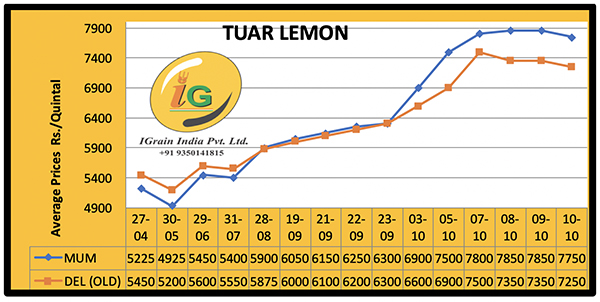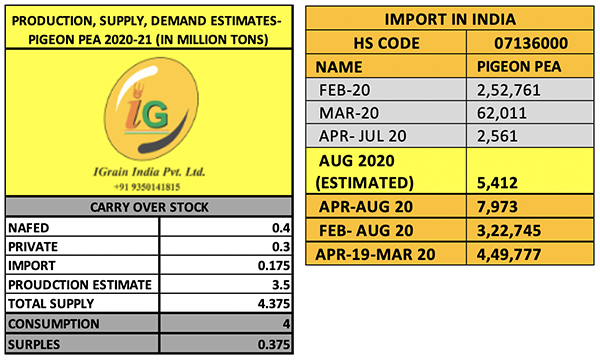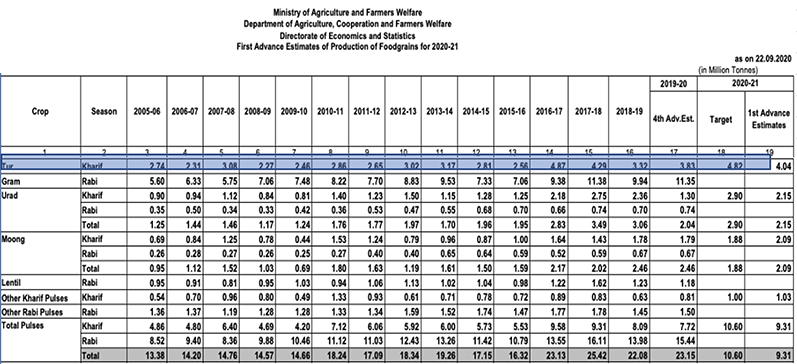October 12, 2020
IGrain’s Rahul Chauhan provides information on pricing and current inventories, as well as import figures and news from domestic and international markets.

Highlights from this past week:
Ports
Availability of Tuar is low at ports. Even in the domestic market, stocks are on the low side. Stockists were not interested in selling at lower prices, and this put pressure on prices. At mid-week, prices increased dramatically by Rs 800/1,000, but eased by the weekend. Compared to the previous weekend, prices were higher by Rs 200/400. Myanmar stocks are lower and trading is occurring at Rs 7,700/7,800. The government is not keen on opening imports as new crop will enter the market in mid-November. Because of the delayed withdrawal of the monsoon, there is a possibility of a late crop harvest. In Karnataka, heavy rains affected the crop. The seeded area is up from last year. If there is good weather moving forward, better production is expected. Additionally, given the demand-supply situation, prices are expected to revive.
New Delhi
In Delhi, pulses millers/processors increased their buying, resulting in a sharp rise of Rs 500/600. With this increase, Delhi tuar prices reached Rs 7,400, Maharashtra line Rs 8,000 rupees, Haryana, central country line and north country line Rs 6,500/6,600 rupees over weekend.
Maharashtra
In Maharashtra, there were fewer new crop arrivals. Due to advance purchases of pulses, the demand for pulses was better in both local and domestic markets. Maharashtra prices saw a good increase of Rs 500/800 over the weekend. With this increase, Latur market prices reached Rs 8,600, Solapur Rs 7,500/8,650, Amravati Rs 8,000/8,500, Akola Rs 8,350 and Nagpur Rs 8,600/8,700. Normal demand is expected.
Karnataka
Like in Maharashtra, in Karnataka arrivals were fewer and demand from millers was better, and prices increased by Rs 600/800 through the end of the week. With this increase, Gulbarga prices reached Rs 8,000/8,400, Raichur Rs 6,079/7,416, Yadgir Rs 8,000/8,029. Currently, demand is down, but is expected to increase further.
Other
A bounce of Rs 700 was recorded in the Katni region, causing prices to hit Rs 9,100/9,300. Similarly, an increase of Rs 600 was recorded in Kanpur and prices reached Rs 7,050/7,100. Trading occurred on increased prices in other markets.
Tuar Dal (Processed Tuar)
There was good demand last week. Due to increased demand, prices reached Rs 12,500-13,000, their highest level in 12 months. As prices rose, the demand for processed Tuar fell by the weekend and prices relaxed by Rs 800/1,200. The average price was Rs 11,000/12,100.




News Blurbs
Food grain production target set at 30.10 million MT
The central government has set a target of 30.10 million MT of food grain production for the entire marketing season of 2020-21, which is about 1.5% more than the 29.665 million MT of the gross production in 2019-20. If achieved, India will have large stocks of food grains.
The production estimate for rice is 11.96 million MT, which is about 1.2 million MT more than the 11.843 million MT produced last season. There has been a huge increase in the area under paddy production in the Kharif season and the crop condition in most parts is very good.
The production of pulses crops has been estimated at 25.6 million MT, which is much higher than the total production of 23.15 million tons for 2019-20 season. Similarly, production of oilseed crops has been estimated at 37 million MT, which is more than the total production of 33.42 million MT the previous season. Mustard production target in the upcoming Rabi season has been set at 12.5 million MT, which is 3.3 million MT more than the government production estimate of 9.2 million tons.
The production area of Kharif crops has jumped rapidly to a new record level of 1113.63 lakh hectares, which is 5.71 percent higher than the previous year. This cycle’s monsoon rains have been 7% above average. This will facilitate the sowing of rabi crops.
Meanwhile, the government has also increased the minimum support price (MSP) for rabi crops. The support price for wheat has been increased by Rs 50 per quintal, Rs 75 for barley, safflower by Rs 112, mustard by Rs 225, gram by Rs 250 and lentil by Rs 300 per quintal (100 Kg).
Need to keep a close watch on the production of pulses
Despite the increase in the sowing area of kharif pulses crops, it is difficult to increase production accordingly. The August flood-rains greatly damaged Mung-Urad crops and now heavy rains are once again seen particularly in South India. Monson is in its withdrawal phase.
Tuar-Pigeon Pea crop is also reported to be damaged in many areas. Early sown crop of Mung has been harvested in Karnataka-Maharashtra, while in other states the crop is ready to harvest.
The urad crop is expected to suffer heavy losses in Madhya Pradesh. The Mung crop in Rajasthan is in good condition but in the previous week some areas were affected by the virus while in Gujarat small losses are reported. It seems that the production of pulses may be either equal to or slightly lower than the previous kharif season. Earlier it was expected to increase by 10-15%.
The situation will become clearer when new crop arrivals peak.
Flooding and rains in northern Karnataka damaged tur crops, delayed harvesting
In August-September, Northern Karnataka- Gulbarga, Bidar, Bijapur, Yadgir and Raichu districts, the main Pigeon pea producing districts, received heavy rains and some parts even flooded. This damaged at least 10% of Arhar/ Tuar(Pigeon Pea) crops and other pulses crops too.
Due to water logging, there is a delay in harvesting and preparation. Usually the tuar harvest starts in mid-November, but this year it seems unlikely to get underway before December. Pigeon pea prices in Maharashtra's benchmark Latur Market yard-Mandi have risen from Rs 5,800 per quintal (100 kg) to Rs 6,700 per quintal during the last month, much higher than the minimum support price of Rs 6,000 per quintal. Tuar dal prices have also risen to Rs 95-105 per kg in different parts of the country.
Tuar prices have risen higher in Karnataka and Maharashtra due to the possibility of crop damage and late arrivals. Despite this, the Central Government has not yet issued licenses to millers for the pigeon pea import quota. The Directorate General of Foreign Trade had announced an import quota of 4 lakh MT for pigeon peas on April 21 during the financial year 2020-21.
If permits are issued now, both imported and domestic Tuar will start hitting markets at the same time, increasing availability.
The government appears to think it has sufficient stocks and imports appear unlikely.
Until new domestic crops arrive, the market will remain on the strong side.
Kharif 2020-21 Pulses production to reach 93.10 lakh MT in Kharif season- Department of Agriculture, Cooperation and Farmers Welfare
The Union Agriculture Ministry released the first advance estimate for pulses crops for the kharif season of 2020-21. Total pulse production is estimated at 9.31 million MT, which is 1.3 million MT below the 10.6 million MT target but 1.6 million MT above 2019-20 kharif production (7.72 million MT).
The Ministry estimates Arhar/Tuar (Pigeon Pea) production increased from 3.83 million MT to 4.04 million MT. Urad production increased from 1.3 million MT last year to 2.15 million MT. Mung production is up from 1.79 million MT last year to 2.09 million MT.
The production of other pulses like Moth is also expected to increase from 0.81 million MT last year to 1.03 million MT this season.
The main pulses grown during the kharif season are moong, urad and arhar. In another report, the Ministry indicates the area seeded to pulses this kharif season increased by 4.75% over last year, from 13.23 million hectares to 13.86 million hectares, which is well above the average of 12.89 million hectares. The area seeded to Arhar-Tuar increased from 4.546 million hectares to 4.824 million hectares. The area seeded to Uard increased from 3.8 million hectares to 3.863 million hectares. The mung area rose from 3.075 million hectares to 3.58 million hectares. Of course, the Ministry of Agriculture has projected a huge increase in the production of kharif pulses crops, but the actual production is likely to be much less. Like last year, Urad and Moong crops suffered losses due to natural disasters. The government’s production estimates are probably based on these seeded area numbers and do not take crop losses into account. Domestic market (wholesale) prices for almost all of the major pulses are higher than the minimum support prices. The support price of arhar and urad is fixed at Rs 6000-6000 per quintal and the support price for moong is around Rs 7,200 per quintal. The government has also announced MSPs for rabi season pulses-gram and lentils. Rabi seeding will start soon.
Abbreviations
Tuar/ Arhar: Pigeon Peas
Mung: Green Mung
Urad: Black Matpe
Chana: Gram
Matar: Pea
Masur: Lentil
Mandi: Market yard
Bhav: Prices
Dal: Processed Pulses (Directly for human consumption)
Rs: Indian Rupees (1$= Rs 73-74)
Rahul Chauhan
Director, IGrain India
igrainind@gmail.com
+91 9350141815
Twitter rc_capricon

Rahul Chauhan / IGrain / India / Tur / Arhar / Pigeon pea / New Delhi / Maharashtra / Karnataka
Disclaimer: The opinions or views expressed in this publication are those of the authors or quoted persons. They do not purport to reflect the opinions or views of the Global Pulse Confederation or its members.